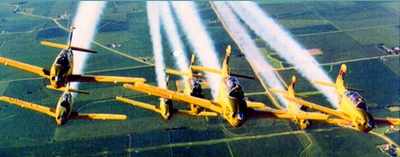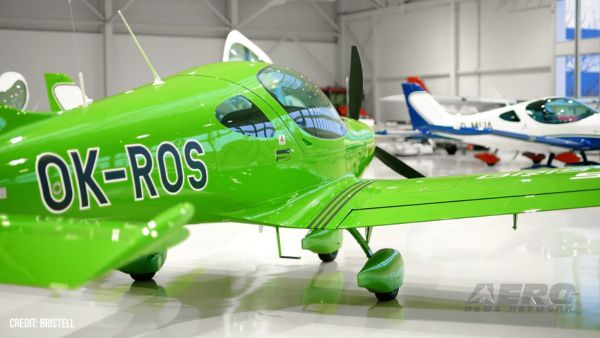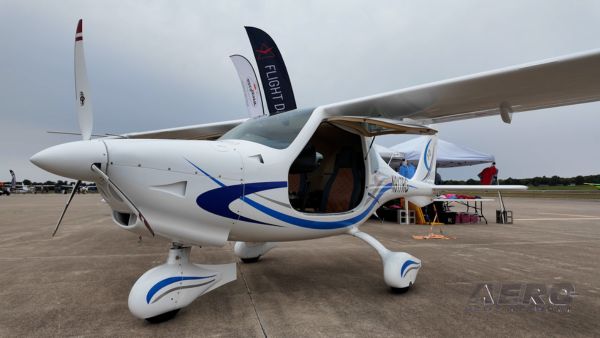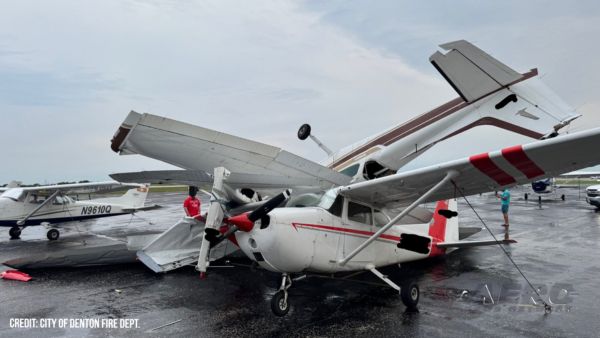By Kevin "Hognose" O'Brien
 Upset is not how we like
things to be. Upset is bad whether we're talking about your spouse,
your stomach, or your airplane. But while an upset spouse or upset
stomach can usually be tamed, an upset airplane might leave your
relatives with no options for a chat with you, short of an Ouija
board. But while most training focuses on keeping you far away from
the edges of the performance envelope where upsets can happen, some
increasingly popular training takes you there deliberately - and
shows you how to come back. In upset recovery training, as offered
by Aviation Safety Training (AST) of Houston, pilots are trained to
bring the plane back to straight and level flight with minimum loss
of altitude and minimum distress to the passengers (not to mention
the plane). Upset recovery training isn't aerobatics; it's
emergency procedures training.
Upset is not how we like
things to be. Upset is bad whether we're talking about your spouse,
your stomach, or your airplane. But while an upset spouse or upset
stomach can usually be tamed, an upset airplane might leave your
relatives with no options for a chat with you, short of an Ouija
board. But while most training focuses on keeping you far away from
the edges of the performance envelope where upsets can happen, some
increasingly popular training takes you there deliberately - and
shows you how to come back. In upset recovery training, as offered
by Aviation Safety Training (AST) of Houston, pilots are trained to
bring the plane back to straight and level flight with minimum loss
of altitude and minimum distress to the passengers (not to mention
the plane). Upset recovery training isn't aerobatics; it's
emergency procedures training.
At AOPA Expo 2003, AST's Rick Gillenwaters explained the need
for and principles behind upset training to an enthusiastic crowd.
Rick is a former military pilot, as are many AST instructors; he
flew F-15s in the USAF. He's now a civilian 737 pilot, but still
retains that fighter-pilot confidence. This broad experience makes
him a good spokesman for AST. The company brings effective training
techniques, honed over decades by the military, to the civilian
pilot.
Many operators offer an upset training syllabus. AST's
particular program is called AMP©, which stands for Advanced
Maneuvering Program. Its objective: to train the pilot to recognize
an upset and react correctly, instinctively, to one.
Task: recover from upsets/unusual
attitudes
Conditions: given a T-34, standing in for
anyplane; an instructor; and training
Standards: minimum altitude loss/minimum distress
to those on board
OK, What's an Upset?
An upset is an
unexpected departure from normal flight attitudes. Some favor a
definition based on more objective criteria; one often cited
is:
- more than 25 degrees pitch up
- more than 10 degrees pitch-down, or
- more than 45 degrees bank angle.
Many things can lead to an upset, including wake turbulence,
mechanical failure, storm conditions, icing, and unusual winds
(i.e., mountain rotors, downbursts).
What Do You Do When It's Green Over Blue?
Underpinning the training is the philosophy that, in a sudden
upset, a pilot will do what is instinctive. Since his natural
instinct (We're headed down - pull back, pull back!) is incorrect
(now he's headed down, and stalled), AST supplants those bad
instincts with new ones, inculcated by practice, drill, repetition.
The technique will be familiar to anyone who ever served in the
military (or played on a sports team). The point is to get the
recovery sequence ingrained to the point where it is all but a
reflex - or as Rick put it, until it's stored in "muscle
memory."
The basic recovery technique in AMP is called the
"mantra," a term they've trademarked.
MANTRA: push/power/rudder/roll
Another phrase is sort of a mantra of its own: Step On
The Sky
Here's what those words mean:
PUSH This
is to unload the aircraft, to reduce Gs, and most especially to
reduce angle of attack and prevent stall. This runs contrary to
normal instinct, which is to pull back on the stick or yoke when
the aircraft is pointed downhill, and pull back harder in
proportion to how steep the nose-down attitude is (even if the
plane is nose-down, but stalled). Such is the normal instinct, but
it's wrong.
POWER Add power. The power is added for
the same reason you pushed - to prevent stall. Again, this is
counterintuitive for the usual 1G pilot. His normal reaction would
be to cut power when pointed down
RUDDER Use rudder to raise the nose
towards the horizon. Because this is for some a hard abstraction to
visualize, Don Wylie, founder, president and chief pilot of AST
adapted the sub-mantra STEP ON THE SKY. This also produces top
rudder, but is easier to remember. The purpose of this is to
prevent loss of altitude or overspeed. This is neither intuitive
nor counterintuitive,
ROLL With the dangers of stall and
overspeed prevented, the pilot can roll the machine back to
wings-level.
These steps are learned as a matter of drill, through
repetition, to make the student internalize this procedure.
However, in practice, the steps are executed rapidly, even
simultaneously. For instance, the PUSH need not (and should not) be
held indefinitely, instead it's all but momentary.
The point of the thing is getting the lift vector oriented so as
to move you away from danger (i.e. terrain). In an upset, the lift
vector is often moving you closer to danger.

The Laundry List of Subjects Covered:
- Aerodynamics review
- Causes of "Upsets"
- AST Lift Demonstration ALD™
- "G" Demonstration
- Physiological and aircraft effects.
- Flight physiology
- Human Factors
- Temporal distortion Hypervigilance-Kinesthetics
- Unusual attitude recoveries
- AST MANTRA™
- AST Lift Vector Management LVM™
- Establishing Muscle Memory™
- Uncommanded excursions (Upsets)
- Runaway trim/hard-over rudder
- Yaw dampener malfunction, etc.
- Wake turbulence and windshear
- Accelerated stalls(recognition and recovery)
- Spins (recognition and recovery)
- Wake turbulence demonstration
That's quite a lot to pack into a rather few hours of training,
but with the techniques developed by Don Wylie and others at AST,
it's certainly do-able.
The Underlying Science
The course doesn't kick right into those muscle-memory
exercises. It begins with an aerodynamic review or refresher -
although sometimes, to Rick's chagrin, it seems more like Intro to
Aerodynamics. To military pilots, managing angle of attack and lift
vectors is second nature; to civilian pilots, even very experienced
ones, these terms are much less well understood. The lift vector
is, as every private student learns a product of angle of attack
and speed. But what private students don't really internalize is
that because the lift vector is a function of these things, it's
completely independent of pitch.
That's not the only part where current training practices leave,
in Rick Gillenwaters's opinion, students unprepared. Nowadays steep
turns aren't even being flown at 60 degrees. As a result, an entire
generation of pilots has been brought up without experiencing even
2 G. (One of the training drills rectifies this deficiency. The
pilots find it surprisingly difficult to raise their feet off the
floor of the machine to put them on the rudder bars, under constant
2G).
This is the latest salvo in a decades-old philosophical battle
between those that believe that training should teach the pilot to
always stay in the comfortable dead center of the plane's safe
performance envelope, and those that believe that pilots should be
taught to respect the edges, but be ready to operate in the whole
envelope. Philosophical fights like this never end, but most
everyone takes a side. Right now, the FAA seems to believe in the
risk-reduction by narrowing the band theory, and aims to reduce
exposure, while the upset-recovery instructors like AST, and their
students, and most of the airlines, and the insurers, seem to
believe in the grow-the-pilot theory, and aim to increase
exposure.
The Administrivia
The two-day initial AMP
course takes place at D.W. Hooks Memorial Airport (KDWH) just
outside Houston. The class has a 1/2 day of academics in the
morning, and the first of two training flights after lunch (lunch
helps settle your stomach; paradoxically, you are more likely to
lose your lunch if you haven't eaten lunch). Pilots will log about
1.15 to 1.30 that day, then debrief. The next day, there are no
academics. A second flight of about the same duration, will a
couple more techniques and reinforce the first ones. Again this
flight is followed by a debrief.
The debriefings are enhanced by video; the planes have several
video cameras installed. (You can see some of the resulting videos
at the AST website).
The pilot gets to take home a video of his flights, along with a
Certificate of Completion (no doubt suitable for framing) and his
training records. In addition, the student gets his Spin
Endorsement and BFR.
Why a T-34?
One is tempted to say that they chose T-34s because they already
had them; AST is a subsidiary of "Texas Air Aces," a
warbird-adventure outfit that primarily caters to nonpilots seeking
to scratch a Walter Mitty itch; would-be aces tangle in T-34s
equipped with laser target-scoring systems and smoke generators.
Rick admits that it's handy to have planes available that can do
double duty. But he continues, in quotes that sound quite like this
material from the company website; "These aircraft are uniquely
suited for this mission in that they closely approximate the
performance… of the general aviation, corporate and airline
fleet." By performance, they mean "maneuverability,
power-to-weight ratios, wing loading and roll/pitch/yaw rates."
Another factor is that the machines can stay up long enough to
conduct the training in two longer, more efficient flights - rather
than suffer the multiple takeoffs, landings and climbs to safe
maneuvering altitude that a shorter-legged machine would
require.
AST doesn't like competitive acro planes for this type of
training because, to put it simply, they don't fly like the planes
that have sufficient fuel capacity to complete the course with a
minimum number of flights. Significantly, the aircraft used by
some other training providers for unusual attitude training are
specifically designed and engineered for "competitive" aerobatics.
They, therefore possess much higher wing loading and
power-to-weight ratios and produce roll, pitch and yaw rates
as much as 8 times higher then that of the aircraft operated
by our clients. "
But… What About the Spars?
As many Aero-News
readers know, the T-34 had a near-death experience after the FAA
reacted to a fatal accident involving a "warbird-adventure" type
school, Sky Warriors, in Atlanta on April 19th, 1999. The spar
failed under significant G loads and the wing separated from the
aircraft in flight; both men on board were fatally injured. On May
28th the FAA issued an incredibly onerous inspection AD (AD
2001-13-18:
http://www.airweb.faa.gov/Regulatory_and_Guidance_Library/rgAD.nsf/WebCurrentADFRMakeModel/3AD30B84E401B11B86256A7D00569653?OpenDocument
), which also drastically reduced the flight envelope for the
machine. This rapid action (for the FAA) indicates how seriously
they viewed the problem. Later, they updated and modified this
guidance in SAIB 02-38. http://av-info.faa.gov/data/SAIB/CE-02-38R1.pdf
[Adobe Acrobat .pdf file]. A new update is probably going to be
issued soon.
Raytheon, which owns the type certificate for the T-34, and
presumably any liability still attendant thereto, was bashed in the
T-34 community as trying to eliminate the machine, and the T-34
owners and maintainers worked to develop alternate means of
compliance with the AD. One of these reinforces the spar with a
doubler, and cold-works the rivet holes. A second adds a strap.
Aviation Safety Training takes another approach, and replaces the
spars completely with Baron spars (this spar is actually a "common
spar" used in several Beechcraft designs). This is called the
"Nogle Common Spar Alternate Means of Compliance." Any of these
mods satisfies the AD and, to the satisfaction of the FAA and the
pilots that fly them, restores at least some of the strength of the
T-34. The mod used by AST is arguably the best, but also one of the
most expensive and $60,000 plus per plane. But it restores the full
aerobatic capability of this retired veteran.
Do it in Your Own Plane?
Yes, AST will train you in your own plane - within the
boundaries fixed by the plane's operating limitations and the FARs.
The T-34s are aerobatic, and stressed for +6 Gs; most client planes
aren't. "We had one guy come here in his King Air," Rick recounted,
"and he didn't think the T-34 training would transfer." He wanted
to do it in his plane. After he did the maneuvers in the T-34, he
did it in his own machine. "We did the same maneuvers, or as nearly
as we could do legally, in his plane," Rick remembered. While the
skeptical pilot and another AST instructor did the maneuvers, Rick
flew chase in a T-34, and shot video. "Except for the limitations
imposed by the TC and regs, the flight looked the same. I put the
video [of the pilot's King Air upset-recovery] on one side of the
screen, and the video from his T-34 [upset training] on the
other."
Cost??
Depending on how you
look at it, AST's AMP could be the most expensive hours you ever
logged, or the cheapest way you ever saved your life. The initial
AMP course is $2,995. (You also have to figure the cost of travel
and an overnight stay in Houston). 1-day refresher is also
available, at $1,495, and according to Rick, it's popular. They
also have an abbreviated "Introductory" Upset Recovery Training
Course, which is (the website says): "a $1495 course consisting of
3 to 4 hours ground training addressing the aerodynamics of
'accelerated' flight and one flight of approx. 1.5 hours
duration."
Flight departments that are interested in this training can
contact AST to talk about tailored training. Company spokesmen
indicate that they'll come to you, if it makes financial sense to
do so. (Given the large number of accidents of transport and
business type aircraft resulting from in-flight loss of control,
many flight departments are sending all their aircrews. The pilots,
who usually enjoy the training, often consider it a benefit.
This is the first time that AST ever presented the program to a
Part 91, price-sensitive audience; they usually promote themselves
to corporate and airline flight departments. As a result, they
usually don't run into price complaints. The airlines and corporate
G-IV and Lear 45 operators think this is money well spent. The
airlines in particular are reputed to be tight-fisted with training
dollars. But they buy this. You might want to think about that.
You can also get a substantial discount from some insurers for
taking this course. The insurance certification is included in the
bag of goodies you take home. Depending on your insurer, the AMP
program may meet their requirements for recurrent training.
What to Do if you're Interested?
Aviation Safety Training has an excellent website at (what
else?) aviationsafetytraining.com. You can also reach them at (800)
544-2237 or (281) 379-2237.
There are other vendors offering similar training; we're sure
that Rick and Don would encourage you to check them all out before
selecting one that meets your needs. After all, over 2,000 pilots
did, and selected Aviation Safety Training.
 Aero-News: Quote of the Day (09.12.25)
Aero-News: Quote of the Day (09.12.25) First-ever Jetson ONE eVTOL Delivery Goes to Oculus Founder
First-ever Jetson ONE eVTOL Delivery Goes to Oculus Founder Hawaiian Airlines, Honolulu CC Start Mx Tech Program
Hawaiian Airlines, Honolulu CC Start Mx Tech Program Bristell Receives First FAA Part 23 Certification for its B23 Trainer
Bristell Receives First FAA Part 23 Certification for its B23 Trainer Blue Alchemist Successfully Completes Critical Design Review
Blue Alchemist Successfully Completes Critical Design Review




